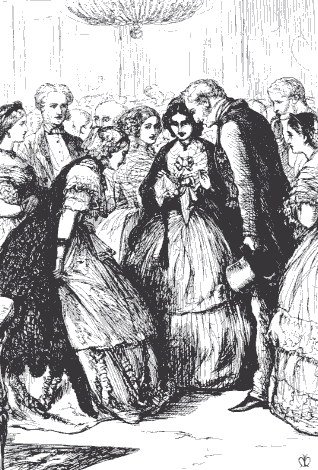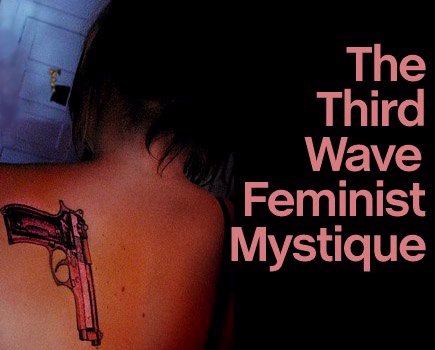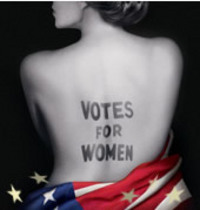 |
||||
|
Breaking the Waves
Breaking the Waves: Continuities and Discontinuities Between Second and Third Wave Feminism
A Work in Progress by Jenn Frederick.Introduction Third Wave¹ feminism emerged in the 1980s, the 1990s, or has not yet emerged, depending on whom you talk to. While some may not see the legitimacy of the Third Wave, the very fact that there are so many young women claiming that identity makes it a very real phenomenon. However, this has led to a fair amount of hostility between feminists of different ages and ideological stances, and this hostility has led to bitter divisions between feminists. Third Wave feminists are generally thought to be those feminists who fall into "Generation X" generally speaking, those born between the late 1960s and the early 1980s. This definition, however, would imply that age is the only determinant for being a Third Wave feminist. It is more complex than that, as some feminists who fall with that age group identify as Second Wave (either denying the existence of the Third Wave or acknowledging the existence but separating themselves from it ideologically) as well as feminists who fall into another category of feminism, that being "post-feminism" (there are some questions as to whether post-feminism is a form of feminism or is anti-feminism, but the point remains that it is distinct from Third Wave feminism). So, if age is not the only determinant, what else distinguishes Third Wave feminism from Second Wave feminism? According to many Third Wave writers, one of the primary distinguishing features is accepting a feminism with contradictions and ambiguities. This is certainly not a completely new stance to undertake, as many Second Wave feminists have, themselves, talked about the deals with the patriarchy they have made in order to survive, and other contradictions and ambiguities that exist within their politics and ideologies. However, this seems to be a much more prominent focus within Third Wave feminism than it was in Second Wave feminism. Third Wave feminists have also openly shunned identity politics, the belief that "it is important to affiliate with those who confront similar experiences based on social group characteristics"², which they see as inherent with Second Wave feminism. The idea that Second Wave feminists believe in identity politics is a generalization that certainly cannot apply to all Second Wave feminists, and the question as to whether identity politics is inherently a negative thing is open for question. Many feminists believe that "the most profound politics come out of one's own identity"³. Nonetheless, in the readings of Third Wave feminists, it is something they tend to believe about Second Wave feminists and tend to believe is inherently negative.
Tension between feminists of different generations are not new. Ruth Rosen4, in her book The World Split Open: How the Modern Women's Movement Changed America, documents some of the tensions that occurred between Second Wave feminists and those of First Wave feminists who were still alive, such as Alice Paul. However, these tensions were minimal, as there were simply fewer First Wave feminists still around and one of the primary goals of First Wave feminism (women's suffrage) had been achieved. Another of the First Wave feminists' goals, passage of the Equal Rights Amendment (ERA), was something that First and Second Wave feminists seemed willing to work together on as a common goal. The tension between Second and Third Wave feminists is much more prominent because of the closeness of the Waves. As a result, this tension has often increased the level of hostility. Some writers, such as Jennifer Baumgarder and Amy Richards5 and Cathryn Bailey6, have likened the hostility between Second and Third Wave feminists to a mother-daughter dichotomy with the daughter trying to break away and gain her own identity and the mother not wanting to fade into the background. While the analogy can be insulting to those on both sides of the situation, many of the similarities cannot be ignored, at least partly because many of the Third Wave feminists are the daughters of Second Wave feminists. Much of what has led to this hostility seems to be a mixture of truth and fallacy on both sides, the fallacies often generated by a lack of knowledge about the Wave the feminist is not a part of. Second Wave feminists often see Third Wave feminists ignoring their feminist history, eschewing theory and even going against that which many Second Wave feminists had fought for. Third Wave feminists often see Second Wave feminists as being too enmeshed in academic feminism, steeped in identity politics and unaccepting of a broader focus of feminist politics. While all of these assertions hold a certain level of truth, they are too broad to generalize to all feminists within their respective Waves. The hostility between the feminist Waves has created divisions among women that must be overcome if we are ever to hope to continue moving feminism forward. Certainly, it is not the first division between feminists. Every Wave contained its own divisions. However, the time spent fighting each other takes away time and energy from fighting the real enemies. Of course, therein lies another division - who the enemy is. I hope to gather opinions about feminists and theoretical stances of each Wave by reading both Second and Third Wave texts, participate in conversations with feminists of both Waves, both within and between the different Waves, as well as by conducting a survey. By identifying the source of the hostility, defining both the truths and the fallacies, I believe that we can begin to overcome the hostility between Second and Third Wave feminists and move to a point of solidarity.
Review of the Literature In order to gain some background on this issue, I will look at the concept of Waves in feminism and how this came about in addition to the history and background of the Second and Third Wave feminisms. The Concept of Waves: Continuity & Discontinuity The first known reference to Waves of feminism was in a statement by Kate Millet who "declared that that the first wave of feminism in the early twentieth century, which lost much of its force with the achievement of women's right to vote, was reborn as a second wave of feminist action in the early 1960s"¹. An early feminist magazine was named The Second Wave, for Kate Millet's statement. While the term and identification with Second Wave seems to be a declaration of continuity with the First Wave of feminism, some see the declaration of a Third Wave as "a means of distancing itself from earlier feminism, as a means of stressing what are perceived as discontinuities with earlier feminist thought and activity"². The First Wave is generally considered to have taken place from 1848 with the first Women's Rights Convention in Seneca Falls to 1920 with the ratification of the 19th amendment (women's suffrage). At that point, many of the First Wave feminists "scattered to work on a variety of issues - child labor protection, prenatal care for mothers, and peace"³. While many of these women were activists during the period from 1920 to the 1960s, there was no "single mass-based social movement"4. Many of these women were committed to "the woman question"; however, they did not call themselves "feminists"5. The rebirth of feminism, as a "single mass-based social movement"6 began in the 1960s. "[T]o call something a wave implies that it is one among others, in some sort of succession, both similar to and different from the other occurrences"7. That is precisely what the Second Wave was, building on many of the successes of the First Wave, reviving some of the failures, and redefining some of the issues. This rebirth, however, occurred after a significant period of time. The distinction between those feminists of the First Wave and those of the Second Wave was clear. "[O]ne of the obvious differences between the first and second waves is time . . . if there is a temporal difference between the second and third waves, it is neither so great nor so visible as that which separates the first from the second. If there is a third wave, it overlaps considerably with the second,"8. The question of temporal differences raises the question of what defines a "Wave" of feminism. While it is true that the Second and Third Waves of feminism overlap significantly, causing some feminists to question where they belong9, it is also true that this new generation, while a continuation of the Second Wave, contains differences. These feminists have grown up in the midst of the fight the Second Wave began. Many of these feminists grew up in a time when they could take for granted rights and privileges that the Second Wave fought hard for. Third Wave feminists are picking up the task of completing the work the Second Wave did, as well as defining new issues for which to fight. "Each generation of women activists leaves an unfinished agenda for the next generation . . . It is for a new generation to identify what they need in order to achieve greater equality"10
The Second Wave While there are some who claim that the First Wave was actually made up of two distinct Waves, making what is known as the Second Wave the Third Wave of feminism¹, common usage declares Second Wave as starting in the 1960s. Just as many of the First Wave feminists emerged from the abolition movement of the early and middle 1800s, the civil rights movement was a breeding ground for second wave feminists. The beginning of the Second Wave drew upon the experiences of women who became seasoned activists while fighting for civil rights, both as mentors and as leaders². With the publication of Betty Friedan's The Feminine Mystique in 1963, many women joined together to combat this "feminine mystique" and gave rise to the Second Wave of feminism. These women began questioning the idea of gender roles³. The results of this questioning have helped restructure institutions around the world and continues to shape public and private life4. In the late 1960s and early 1970s, divisions began to appear in the Women's Movement. While some, Women's Rights activists, focused on the similarities between men and women and fought for equal rights for women; others, the Women's Liberation activists, focused on the deeply rooted differences between men and women and fought for more radical changes than formal equality5.
|
||||
|
|
||||
|
Despite these divisions, all Second Wave feminists instituted many changes in society for the benefit of all women. They "questioned nearly everything, transformed much of American culture, expanded the idea of democracy by insisting that equality had to include the realities of its women citizens, and catapulted women's issues onto a global stage. Their greatest accomplishment was to change the terms of debate, so that women mattered"6. The fight for equality, however, is not over. The Second Wave left much unfinished. "They were unable to change most institutions, to gain greater economic justice for poor women, or to convince society that child care is the responsibility of the whole society. As a result, American women won the right to 'have it all,' but only if they 'did it all'"7. The Second Wave is far from over. Many Second Wave feminists are still fighting. But a new generation, the Third Wave, has picked up where many Second Wave feminists left off, creating their own fight, their own activism.
The Third Wave If there were one way to describe the Third Wave of feminism, it would have to be a movement of young feminists who not only confront but embrace contradiction and ambiguity¹ (Bailey 1997; Baumgardner & Richards 2000; Drake, 1997; Drake & Heywood 1997; Findlen 1995; Jacobs, 2001a; Jacobs 2001b; Orr 1997; Rubin & Nemeroff 2001; Walker, 1995). No complex movement can be fully summed up by one short phrase; nonetheless, "embracing contradiction and ambiguity" is the common theme running through literature by and about Third Wave feminists. Rather than seeking perfect consistency in their lives and politics, Third Wavers accept that lives lived in patriarchy will inevitably include compromises and complexity. Therefore, for instance, a Third Waver might simultaneously recognize the use of make-up by patriarchy to tell women that their unmodified faces are inadequate, and at the same time claim the right to wear lipstick for fun. As Krista Jacobs², editor of the on-line zine Sexing the Political, states, "young women are celebrating their pluralities, embracing their personal and political contradictions." This acceptance and celebration of ambiguity and contradiction is also seen by some Third Wavers as that which "unites the Third Wave. [It] is our negotiation of contradiction, our rejection of dogma, our need to say 'both/and,'"³. Just as the Second Wave had its differing theories and ideologies, many Third Wavers hold varying views on what feminism is about. However, beyond the age distinction, the acceptance of contradictions seems to be a unifying aspect and rallying point. "Even as different strains of feminism and activism sometimes directly contradict each other, they are all part of our Third Wave lives, our thinking, and our praxes: we are products of all the contradictory definitions of and differences within feminism, beasts of such a hybrid kind that perhaps we need a altogether"4. The term "Third Wave" can be traced back to the mid-1980s when a diverse group of feminist activists and academics teamed up to create an as yet unpublished anthology they titled The Third Wave: Feminist Perspectives on Racism5. While the primary focus was on multiracial aspects of feminism rather than age, the term continued to circulate among some feminists and reappeared in 1992 in response to the nation-wide publicity surrounding the Clarence Thomas confirmation hearing and the William Kennedy Smith trial, both of which had occurred in 1991. "One hundred young feminists gathered in New York City and organized themselves into and activist network they called 'The Third Wave.' . . . The first project was Freedom Ride 1992, a three-week bus tour to register voters in poor communities of color across the country. In this incarnation, the third wave emphasis was on organizing young feminists, and this is the emphasis that stuck"6. The women and men of the Third Wave came of age at a time when feminism had already become a part of society. They grew up with the "sense of entitlement feminism made possible"7. Third Wave feminists can barely remember, or were not even born, when Second Wave feminists established sexual harassment laws, made it possible for women to obtain credit without their husbands' approval, defined and strengthened laws against rape, made abortion legal in every state and fought for the right for women to be in the work force. We are the first generation for whom feminism has been entwined in the fabric of our lives. . . . Maybe we're not as unified as the generation that preceded us. Maybe we're just not as categorizable. . . . So what may appear to be a splintering of this generation comes from an honest assessment of our differences as each of us defines her place and role in feminism. We are determined, as Sonja D. Curry-Johnson writes, "to bring our whole selves to the table"8. The issues that Third Wave feminists face are, for the most part, different than those faced by Second Wave feminists9. "We grew up in a different world. We run into different problems then you did. Is it any wonder that we work with different issues?" Alana Wingfoot10 asks. "The meaning of younger women's actions and attitudes cannot be assessed without keeping in mind that the backdrop against which their actions are performed is, in many cases, significantly different"11. It is important to avoid evaluating the actions, behaviors, and activism taken on by Third Wave feminists in the context of what was happening thirty years ago and instead analyze it within the context of what is happening today. At about the same time that Third Wave was starting, a group of young women, primarily in the Northwest, were starting their own movement that became a big part of Third Wave feminism. This group, Riot Grrrl, emerged from the punk rock music scene in the early 1990s when many of the women involved in the punk rock scene became fed up with the male standard in punk12. Much of the Riot Grrrl rhetoric embraces anger, especially related to the personal13. While there are no official "leaders" of Riot Grrrl, as with Third Wave, Kathleen Hanna, former lead singer of the band Bikini Kill and current lead singer of Le Tigre as well as the cofounder of Riot Grrrl Press, has become one of the primary voices of Riot Grrrl. Hanna emphasizes feminism in her writing and her music.
To me, a big part of feminism (or whatever you wanna call the rejection of the equation, girl=dumb) is the simple assertion that us girls are important. Our bodiesheartsminds are important enough that we will defend them, protect them, ourselves. We don't have to live lives that are filled up with events that are really just sentimentalized versions of abuse. We don't wanna live that way and we don't have to14. Riot Grrrls, and Third Wave feminists, many times, are fighting new and different battles than Second Wave feminists are, and Third Wave feminists have been raised to protect and defend their rights and often even given a sense of entitlement to these rights. However, some of the battles remain the same and this sense of entitlement is not enough to protect them. That does not stop these women and men from fighting. On July 7, 1993, Mia Zapata, lead singer of the Seattle-based band The Gits, was raped and murdered, her body left in an alley just hours after spending time with friends in a local bar15. In response to this horrific death, many of her friends, other members of the Riot Grrrl scene, and members of the broader music scene under the leadership of Valerie Agnew, drummer for The Gits, banded together to form an organization to honor Zapata. Home Alive is an organization that emphasizes self-protection by writing articles, teaching classes, funding art projects and concerts, and providing legal information on issues of self-defense, rape and assault. This group produced a benefit album, titled The Art of Self Defense, in memory of Zapata. This album includes 45 songs and poems by both well-known and unknown bands and singers such as Joan Jett, Nirvana, Pearl Jam, Ann and Nancy Wilson, 7 Year Bitch, Jim Carroll, and even a few songs by The Gits (both with and without Zapata). All of the songs deal with the pain and anger surrounding Zapata's death as well as general songs about rape and abuse and women protecting themselves and finding safe spaces. "It is grounded in the gap between male and female, laced with tales of threat, regret and anger. It exposes much about the power of rock - and not every part of that is pretty . . . there's no CD or 'tribute' like it. Violent, intense and passionate, it pulls off the trick of pulling life from death."16. This is but one example of the commitment of Third Wave feminists (particularly Riot Grrrls and their supporters) as well as the type of activism taken on by many of these feminists. Third Wave feminism is often compared to, and is certainly an outgrowth of, multiracial feminism, postmodern feminism, and queer theory17. The connection with postmodern feminism is an interesting example of the contradictions inherent in Third Wave feminism.
Certainly, there are many similarities between postmodern feminism and Third Wave feminism. Postmodern feminists reject the idea that there is one way women are oppressed and that there is one way to overcome this, the idea that there is a particular way to be a "good feminist," a duality of thinking and that there is an "essential unity of self through time and space termed self identity"18 [emphasis in original]. In addition, postmodern feminists celebrate women's bodies and femininity19. However, while there are most certainly some Third Wavers who are also post-modern feminists, there are several aspects of postmodernism that contradict Third Wave feminism as a whole. For instance, Third Wave tends to reject academic feminism20 while postmodern feminism, like postmodernism as a whole, is firmly grounded in academic writing, so much so that many see postmodern feminists as being more grounded in theory than in praxis21. Many view postmodern feminists as being "deliberately opaque [and] view[ing] clarity as one of the seven deadly sins of 'the phallogocentric order'"22 and "use[ing] language and ideas in such a specific way that no one else can understand what they are doing"23. In opposition to this, many Third Wave feminists write in non-academic ways, purposely designed to reach the masses, rather than only academics. Nomy Lamm states, "The fact that I write like this cuz it's the way I want to write makes this world just that much safer for me" 24. Indeed, some Third Wave feminists reject postmodernism, particularly its analysis of sexuality. "[P]ostmodernism seem to say yes indiscriminately to all forms of 'disruptive' sexuality. By doing so, it sanctions the production of new sexualities without providing coherent political strategies through which to evaluate them,"25. Third Wavers are often caught in the middle of the of what many see as a "prudish" view of many Second Wave feminists who see all sexual relations as oppressive26 and the postmodern embracing of 'disruptive sexuality' without analysis. "This leaves young feminists either alienated, confused, or in the sex shop, spending lots of money on overpriced sex toys" 27.
Review of the Literature Conclusion There are many distinctions between Second and Third Wave feminists, primarily associated with how they each relate to life and society based on their own past experiences and the ideological views they hold. The lack of a temporal distinction between the waves, however, leaves some feminists questioning the existence of a Third Wave.
|
||||
 |
|
 |
||







